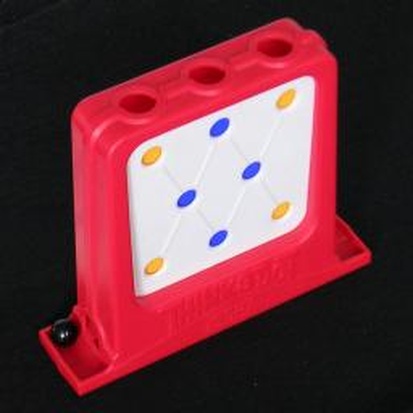Think-a-Dot
- Company :
- E.S.R. Inc.
- Designer :
- Joseph A. Weisbecker
- Year :
- 1966
Think-a-Dot has an upright frame with three openings at the top, into which you can drop a marble. The marble travels through and drops out the bottom. There are eight dots on the front of the frame, in rows of three, two, and three, and they are yellow or blue. They indicate the state of a flip-flop gate inside the frame. If a marble reaches a gate, it is deflected either left or right depending on the state of the gate, and as the marble passes, the gate will flip over to the other state.
At the start you tilt the frame to the right (or left), so that all the gates face the same way. The four corner gates are coloured differently than the rest, so the corner dots will be yellow, and the rest blue (or vice versa if you tilted it to the left). Given a particular target pattern of dots, the aim is to drop the marble into the holes at the top until the target pattern is reached, preferably in as few moves as possible.
This puzzle was made by E.S.R. Inc. in around 1966. Its patent, US 3,388,483, was filed by Joseph A. Weisbecker in July 21, 1966, and granted June 18, 1968. The letters E.S.R. stand for Education Science Research (not Edmund Scientific as is sometimes thought) and they made several fascinating contraptions:

